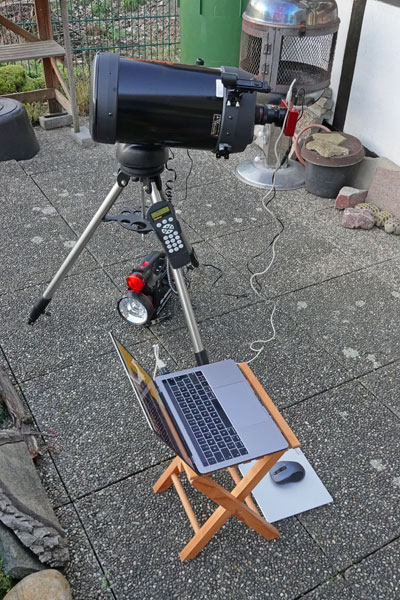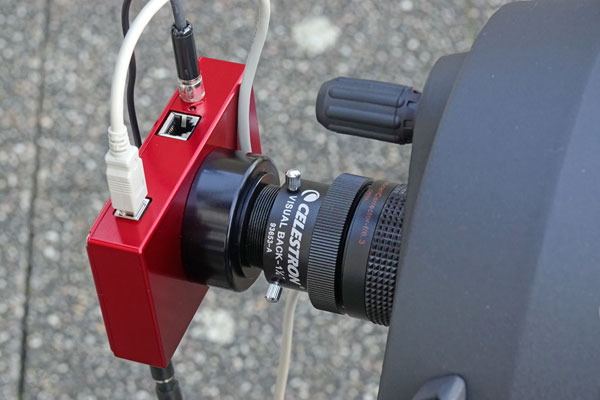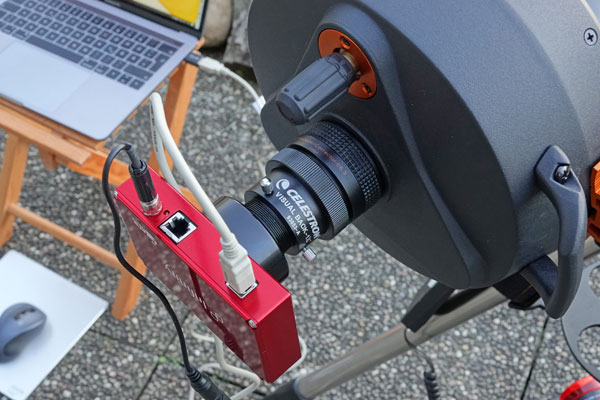Deep Sky Observations with Atik Infinity 2020
Conditions | Observation Overview | Remarks | References
Archive
In 2020, I used the Atik Infinity camera again after a long break (in 2019 I did not use it at all), and this was at the C8. In February, I used reducers for this, in December none (direct connection of the camera to the 1.25" visual back). Prior to these observations, I did "dry runs" to see with which equipment I would get into focus with the Atik Infinity. See page Atik Infinity Colour Camera - Further Experiences for details on the dry runs and observations.
In contrast to the first two years 2017 and 2018, I present the photos, except in galleries, only directly on the detail pages for the sky objects. So there are no more pages for single "observation days" in order to keep the effort a bit lower.
Note: I sold my Atik Infinity at the beginning of January 2023.
Conditions
Sky Region and Objects
I looked into different sky regions, so a description does not make much sense here.
Overview Map
Since the observations are separated through a long period of time, a sky map does not make much sense.
Observation Time
The observations started every day when it was sufficiently dark.
Observation Location
All observations were conducted in Mühlhausen/Kraichgau (Germany):
- Coordinates: 49° 15′ N , 8° 43′ E
- Coordinates (dec.): 49,25° N, 8,72° E
Equipment Used
Camera, Laptop, Focal Reducer, GoTo Mount, Power Supply
Of course, the Atik Infinity camera is needed for taking photos. To operate the camera, a laptop on which the control application runs is also required. Depending on the telescope tube used, focal length extenders (Barlow lens, focal extender) or reducers must also be used. This is indicated for the respective observations.
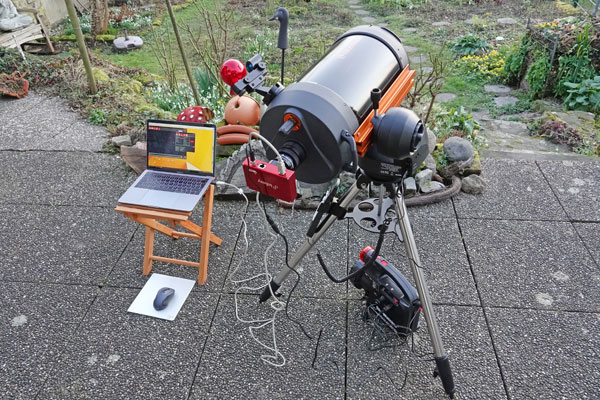 |
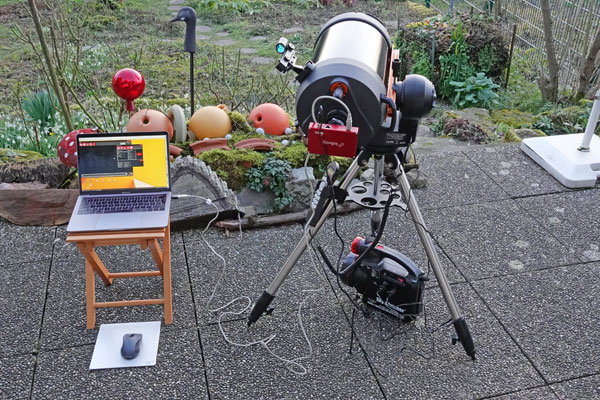 |
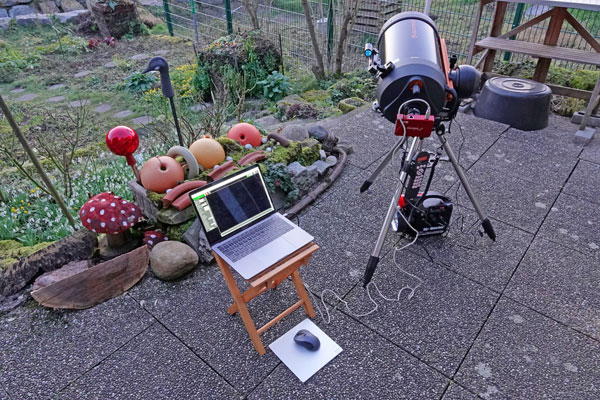 |
|
Atik Infinity connected via f/6.3 reducer/corrector and 1,25" visual back to C8 |
Ditto |
In addition, the telescope tube has always to be mounted on my Star Discovery GoTo mount because sky objects need to be tracked when being observed and photographed with a camera. And last but not least, you need a 12 V power supply for the camera and GoTo mount (and possibly one for the laptop).
Telescope Tubes
Celestron C8
I acquired this tube (2032 mm, f/10) at the end of 2019. On this tube, the camera gets into focus when using focal length reducers, but also completely without reducers. Celestron's f/6.3 reducer/corrector was specifically designed for this tube (and similar ones). In February, I also coupled this reducer with a 0.5 x reducer from TS-Optics (no longer in my possession), while in December I observed completely without reducer.
General Conditions
In general, the sky above Mühlhausen/Kraichgau is "light-polluted" and does not invite you to search for deep sky objects. Cameras will find the objects even in worse conditions, but really good results are obtained only under dark skies.
Observation Overview
Observation Details
| Date | Observed Objects | Further Observations and Remarks | Devices Used | Eyepieces Used | General Remarks |
| 15.3. MH |
OC: M 41, NGC 2264 GN: M 42, NGC 2024 |
f/6.3 Reducer: M 41, M 42 (Orion Nebula), NGC 2024 (Flame Nebula) f/6.3 und 0.5 Reducer: M 41, M 42 (Orion Nebula), NGC 2024 (Flame Nebula), NGC 2264 (Christmas Tree Cluster)
|
C8 on Star Discovery with Atik Infinity, SynScan WLAN with iPhone app 1-star-alignment via Synscan app |
f/6,3 reducer/corrector (Celestron), 0.5 x reducer (TS-Optics) | Planned: M 93, M 41, M 46, M 47, M 48, M 50, B 33?, NGC 2024, NGC 2244,
NGC 2264, NGC 2392 M 35, M 36, M 37, M 38 The Infinity software got often stuck and had to be restarted. |
| 17.12. MH |
GC: M 15 | No Reducer: M 15; M 57and NGC 457 somehow seen, but I was not able to take photos |
C8 on Star Discovery with Atik Infinity, 23 mm crosshair eyepiece 2-star-alignment via handbox |
--- | Planned: M 15, M 57, NGC 457, ...
The Infinity software made it hard for me to center objects in the image field, because the image was often not updated in live view mode. |
Bold: First observation during this observation period; G = galaxy, OC = open star cluster, GC = globular star cluster, P = star pattern
Overview of the Observed Sky Objects (Mostly Objects Found)
|
DSO Details
|
Name | Constellation | Type | Bino* | Tube | Remarks |
| M 15 | Pegasus | GC | C8 | Smaller than M 13, bright core | ||
| M 41 | Canis Major | OC | C8R | Missed | ||
| M 42 | Orion | C8R | ||||
| NGC 2024 | Flame Nebula | Orion | OC | C8R | ||
| NGC 2264 | Christmas Tree Cluster | Monoceros | G | C8R | Missed |
*) 10 x 25 binoculars; G = galaxy, OC = open star cluster, GC = globular star cluster, DS = double star, SP = star pattern
Remarks
Preparation
When searching for deep sky objects, a good preparation is obligatory - you read this, and I can confirm it. "Good preparation" means, on the one hand, that you compile a list of objects that you want to observe, including notes on where and how to find them.
On the other hand, even when doing "quick astro photography" with the Atik Infinity camera (a variety of "video astronomy") more technology has to be prepared than for purely visual observation, especially if you just put a small Dobson or Maksutov telescope on the terrace table for this... Above, I describe, what equipment I use and need for taking photos with the Atik Infinity camera.
References
Books
- Michael Feiler & Philip Novak (2023). Deep Sky Reiseatlas (5. Auflage), Oculum Verlag (ISBN 978-3-949370-04-5)
www.oculum-verlag.de/detailview?no=608 - Ronald Stoyan (2021). Deep Sky Reiseführer (6. Auflage), Oculum Verlag (ISBN 978-3-938469-72-9)
www.oculum-verlag.de/detailview?no=603 - Erich Karkoschka (2022). Atlas für Himmelsbeobachter, Kosmos Verlag (EAN: 9783440173602)
www.kosmos.de/de/atlas-fur-himmelsbeobachter_1074889_9783440173602
On this Website
- Overview of Observations
- Celestron C8 OTA Information (8" Schmidt-Cassegrain)
- Sky-Watcher Star Discovery AZ GoTo Mount Information
- Sky-Watcher SynScan WLAN Information
- Atik Infinity Colour Camera - Information
| 28.04.2024 |
